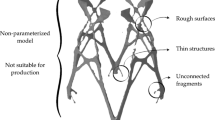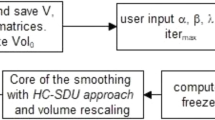Abstract
The main objective of this research is to identify ways to simplify the STL meshes, while simultaneously maintaining the accuracy of the STL file. It demonstrates a technique to simplify large and complex STL triangular meshes and to optimise STL shape for rapid prototyping and manufacture. STL mesh re-triangulation can be separated into two processes, i.e., mesh deletion and mesh rearrangement. In the mesh deletion process, two kinds of weighted-value ratio algorithms can be chosen for determining the suitable value of STL mesh deletion. A genetic algorithm that incorporated fitness functions was used for the optimisation of the rearranged STL meshes. Two case studies of STL mesh reconstruction, which examine the effects of the algorithms, are presented. These studies show that optimisation of the shape of the STL file reduces its size, resulting in a reduction of the fabrication time and improvement of the rapid prototyping process.
Similar content being viewed by others
References
Furrens KK (1999) Standards for the rapid prototyping industry. Rapid Prototyping Journal 5(4):169–178
Chua CK, Leong KF, Lim CS (2003) Rapid prototyping: principles and applications, 2nd Eds, Ch 6. World Scientific
Kumar V, Dutta D (1997) An assessment of data formats for layered manufacturing. Advances in Engineering Software 28:151–164
Lee KH, Woo H (2000) Direct integration of reverse engineering and rapid prototyping. Computers & Industrial Engineering 38:21–38
Nee AYC, Fuh JYH, Miyazawa T (2001) On the improvement of the stereolithography (SL) process. Journal of Materials Processing Technology 113:262–268
Leong KF, Chua CK, Ng YM (1996) A Study of Stereolithographic File Errors and Repair, Part I - Generic Solutions. International Journal of Advanced Manufacturing Technologies 12(6):407–414
Leong KF, Chua CK, Ng YM (1996) A study of stereolithographic file errors and repair, Part II - special cases. International Journal of Advanced Manufacturing Technologies 12(6):415–422
Zhang LC, Han M, Huang SH (2003) CS file – an improved interface between CAD and rapid prototyping systems. Int J Adv Manuf Technol 21:15–19
Hur SM, Kim HC, Lee SH (2002) STL file generation with data reduction by the Delaunay triangulation method in reverse engineering. Int J Adv Manuf Technol 19:669–678
Gieng TS, Joy KI, Schussman GL, Trotts IJ (1998) Constructing hierarchies for triangle meshes. IEEE Transactions on Visualization and Computer Graphics 4(2):145–161
Hamann, B (1994) A data reduction scheme for triangulated surfaces. Computer Aided Geometric Design 11:197–214
Eastlick M, Maddock S (2001) Triangle-mesh simplification using error polyhedra. Proceedings of Euro Graphics. University College London, UK 2001, p 1–10
Wang CCL, Yuen MMF (2001) A generic algorithm for mesh optimisation. Int J Adv Manuf Technol 18:739–744
Kalvin AD, Taylor RH (1996) Superfaces: polygonal mesh simplification with bounded error. IEEE Computer Graphics and Applications 16(3):64–77
Chen YH, Ng CT, Wang YZ (1999) Generation of and STL file from 3D measurement data with user-controlled data reduction. Int J Adv Manuf Technol 15:127–131
Chen YH, Ng, CT (1997) Integrated reverse engineering and rapid prototyping. Computers ind Engng 33(3–4):481–484
Chen YH, Wang YZ (1999) Genetic algorithms for optimized re-triangulation in the context of reverse engineering. Computer Aided Design 31:261–271
Tian XD, Wang YX, Zhou XH, Ruan XY (2002) Mesh simplification based on super-face and genetic algorithm in reverse engineering. Int J Adv Manuf Technol 20:303–312
Qin KH, Wang WP, Gong ML (1997) A genetic algorithm for the minimum weight triangulation, Proceeding of the IEEE Conference on Evolutionary Computation, 13–16 April. Indianapolis, IN, USA, pp 541–546
Kolingerova I, Ferko A (2001) Multicriteria optimized triangulations. The Visual Computer 17:380–395
Szilvasi-Nagy M, Matyasi GY (2003) Analysis of STL files. Mathematical and Computer Modelling 38:945–960
Michalewicz Z (1999) Genetic algorithms + data structure = evolution programs, 3rd Eds. Springer-Verlag
Author information
Authors and Affiliations
Corresponding author
Rights and permissions
About this article
Cite this article
Wang, CS., Chang, TR. Re-triangulation in STL meshes for rapid prototyping and manufacture. Int J Adv Manuf Technol 37, 770–781 (2008). https://doi.org/10.1007/s00170-007-1009-9
Received:
Accepted:
Published:
Issue Date:
DOI: https://doi.org/10.1007/s00170-007-1009-9




